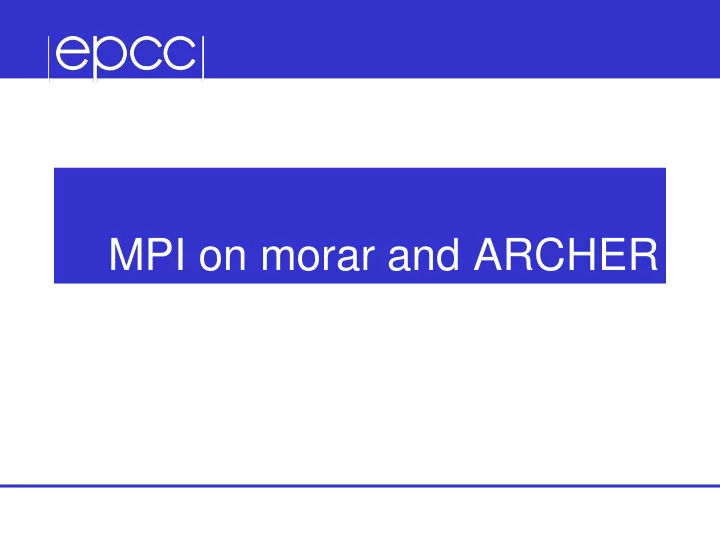

MPI on morar and ARCHER
Access morar available directly from CP-Lab machines external access to morar: gateway: ssh – X user@ph-cplab.ph.ed.ac.uk then: ssh – X cplabXXX (pick your favourite machine) external access to ARCHER: ssh – X user@login.archer.ac.uk You can access systems using ssh from anywhere – Trivial for Linux – Mac • manually enable the X server to display any graphics – Windows • need to install an X server program, eg xming (which is free!)
Useful files and templates Take a copy of MPP-templates.tar – stored at learn.ed.ac.uk unpack: tar xvf MPP-templates.tar
Compiling MPI Programs on morar Fortran programmers use mpif90 C programmers use mpicc There is nothing magic about these MPI compilers! – simply wrappers which automatically include various libraries etc – compilation done by standard (Portland Group) compilers • pgf90 and pgcc You can use the supplied Makefiles for convenience – make – f Makefile_c – make – f Makefile_f90 Easiest to make a copy of one of these called “Makefile” – also need to change the line “MF=“ in the Makefile itself
Running interactively Timings will not be reliable – shared with other users, many more processes than processors – but very useful during development and for debugging mpiexec – n 4 ./mpiprog.exe – runs your code on 4 processes NOTE – output might be buffered – if your program crashes, you may see no output at all May need to explicitly flush prints to screen – FLUSH(6) – fflush(stdout);
Running on morar Run via a batch system – on morar we use Sun Grid Engine (SGE) – submit a script that then launches your program In MPP-templates/ is a standard batch script: mpibatch.sge – make a copy of this file with a name that matches your executable, eg – user@cplab$ cp mpibatch.sge hello.sge To run on 4 processors: qsub -pe mpi 4 hello.sge – automatically runs executable called “hello” – output will appear in a file called hello.sge.oXXXXX – can follow job progress using qmon GUI or qstat or qstat –u “*” – script also times your program using the Unix “time” command – full instructions included as comments in the template – no need to alter the script - just rename it as appropriate • eg to run a program “pingpong” make another copy called “pingpong.sge”
Morar idiosyncracies Do not use the default version of MPI – very old and out-of-date Access correct version: module load mpich2-pgi – add this to end of your .bash_profile file in home directory – to check (similarly for mpif90) user@cplab$ which mpicc /opt/mpich2-pgi/bin/mpicc Output files – will probably see a file called hello.sge.eXXXXX – contains a spurious error message – ignore it!
Compiling MPI Programs on ARCHER Fortran programmers use ftn C programmers use cc There is nothing magic about these MPI compilers! – simply wrappers which automatically include various libraries etc – compilation done by standard (Cray) compilers • crayftn and craycc You can use the supplied Makefiles for convenience – make – f Makefile_c – make – f Makefile_f90 Easiest to make a copy of one of these called “Makefile” – also need to change the line “MF=“ in the Makefile itself
ARCHER idiosyncracies Not possible to run directly on front-end Can be a substantial delay in batch queues – we may sometimes have dedicated queues for the course – instant turnaround! Cannot run from the home file system – back-end nodes can only see the work file system Recommendation – do everything in /work/ – change directory to /work/y14/y14/guestXX/
Running on ARCHER back-end Run via a batch system – on ARCHER we use the Portable Batch System (PBS) – submit a script that then launches your program In MPP-templates/ is a standard batch script: mpibatch.pbs – make a copy of this file with a name that matches your executable, eg – user@archer$ cp mpibatch.pbs hello.pbs Submit: qsub – q <reserved queue ID> hello.pbs – we have a reserved queue RXXXXXX for the courses – you will need to alter NPROCS (the argument to “ aprun ”) by hand – … and select more than one node for more than 24 processes – output will appear in a file called hello.pbs.oXXXXX – can follow job progress using qstat command – script also times your program using the Unix “time” command – full instructions included as comments in the template
C++ Interface MPI is not an OO interface – however, can be called from C++ Function calls are different, eg: – MPI::Intracomm comm; C++ interface is – ... – MPI::Init(); now deprecated – comm = MPI::COMM_WORLD; – rank = comm.Get_rank(); Advised to cross- – size = comm.Get_size(); call to C Compiler is called mpicxx – see hello.cc and Makefile_cc
Documentation MPI Standard available online – See: http://www.mpi-forum.org/docs/ Available in printed form – http://www.hlrs.de/mpi/mpi22/ Man pages available on CP-Lab and ARCHER – must use the C style of naming: man MPI_Routine_name, eg: – user@cplab$ man MPI_Init
MPI Books
Exercise: Hello World The minimal MPI program See Exercise 1 on the exercise sheet Write an MPI program that prints a message to the screen Main purpose is to get you compiling and running parallel programs on ness – also illustrates the SPMD model and use of basic MPI calls We supply some very basic template code – see pages 4 and 5 of the notes as well
Recommend
More recommend